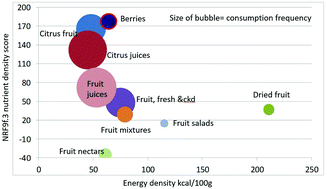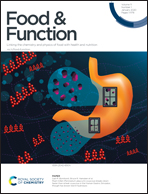A new category-specific nutrient rich food (NRF9f.3) score adds flavonoids to assess nutrient density of fruit†
Abstract
Nutrient profiling (NP) models, intended to capture the full nutritional value of plant-based foods, ought to incorporate bioactive phytochemicals, including flavonoids, in addition to standard nutrients. The well-established Nutrient Rich Food (NRF9.3) score is based on 9 nutrients to encourage (protein, fiber, vitamins A, C, D and calcium, iron, potassium, magnesium) and 3 nutrients to limit (saturated fat, added sugar, sodium). The new category-specific NRF9f.3 score kept the same algorithm based on sums of percent daily values (%DVs) but swapped vitamin D for total flavonoids from the USDA database. NRF9f.3 was applied to the USDA fruit group categories, comparing nutrient density of citrus fruit, citrus juice, dried fruit, raw and cooked fruit, berries, fruit mixtures, fruit salads, non-citrus fruit juice, and fruit nectars. Adding total flavonoids to NRF9f.3 allowed for a recalibration of fruit total nutritional value. Citrus fruits and juices had significantly higher flavanones, berries had significantly higher anthocyanidins, and dried fruit and berries had significantly higher flavan-3-ols, than other fruits (all p < 0.05). Citrus fruit, citrus juice and berries had significantly higher NRFf9.3 scores than all other fruit subcategories (p < 0,05), but were not different from each other. The more innovative NP models are both category specific and make effective use of new nutrient composition databases. NRF9.3 when applied to the fruit group discriminates primarily on fiber, vitamin C, and added sugar content. Incorporating flavonoid and polyphenol data modernizes NP models to better capture nutrient density of plant foods that can aid in dietary guidance and policy development to improve diversity and nutritional value of the diet.

- This article is part of the themed collections: Food & Function Recent HOT articles and Berry Health Benefits Symposium


 Please wait while we load your content...
Please wait while we load your content...